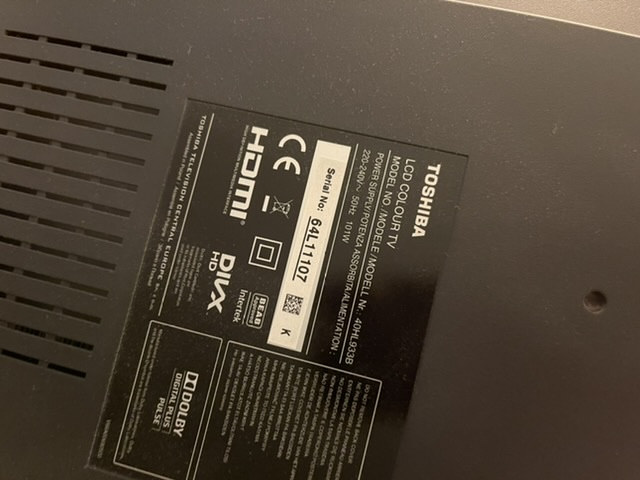We'd like to remind Forumites to please avoid political debate on the Forum... Read More »
We're aware that some users are experiencing technical issues which the team are working to resolve. See the Community Noticeboard for more info. Thank you for your patience.
📨 Have you signed up to the Forum's new Email Digest yet? Get a selection of trending threads sent straight to your inbox daily, weekly or monthly!
New tv advice
Options
adonis10
Posts: 1,810 Forumite






in Techie Stuff
Looking to upgrade from our 8 year old, 42” Toshiba 40HL933B (TOSHIBA 40HL933B, 40 inch HL Series Full HD 1080p LED TV with Freeview) for the lounge. Size of room dictates a 50” as the max size. More details below:
Considering the following but unsure if the jump from £799 to £1,149 is worth it, although the latter looks lovely in the shop.
Option 1 SAMSUNG QE50Q80AATXXU 50" Smart 4K Ultra HD HDR QLED TV with Bixby, Alexa & Google Assistant
Option 2 SAMSUNG QE50QN94AATXXU 50" Smart 4K Ultra HD HDR Neo QLED TV with Bixby, Alexa & Google Assistant
Help!
Please ask any relevant questions as I appreciate I have only provided fairly limited info.
- fairly light room (QLED rather than OLED?)
- not used for gaming
- general tv, sports and film
- possibly wall mounted in time but currently at eye height circa 3m from sofa
- Budget was £800-900 but could extend to the £1,149 if really worth it. No more.
Considering the following but unsure if the jump from £799 to £1,149 is worth it, although the latter looks lovely in the shop.
Option 1 SAMSUNG QE50Q80AATXXU 50" Smart 4K Ultra HD HDR QLED TV with Bixby, Alexa & Google Assistant
Option 2 SAMSUNG QE50QN94AATXXU 50" Smart 4K Ultra HD HDR Neo QLED TV with Bixby, Alexa & Google Assistant
Help!
Please ask any relevant questions as I appreciate I have only provided fairly limited info.
0
Comments
-
It's personal for sure, but I wouldn't buy a non-OLED TV after using one for the last 6 years.
LG's 48 inch C1 is around £800-£900 depending on sales, and sounds like it would be perfect.1 -
 Weirdly the model comes up as LED but on the back of the set it’s an LCD (see pic).Out of interest why would you not go from the 8 year old Toshiba to a QLED? It looks fantastic in store!0
Weirdly the model comes up as LED but on the back of the set it’s an LCD (see pic).Out of interest why would you not go from the 8 year old Toshiba to a QLED? It looks fantastic in store!0 -
Samsungs neo qled sets are amazing, not quite the blacks of oled but the clarity and brightness of the picture is amazing. Go to curry’s and have a look at them, you’ll see what I mean.1
-
Yeah, been a couple of times and they look great. I’ve really wanted to like the £799 one enough but it just looks so inferior to the £1149 version. Can’t bring myself to spend that much on a tv but one of those now it’s in my head that it is so good I don’t want to drop down to the lower one!Deleted_User said:Samsungs neo qled sets are amazing, not quite the blacks of oled but the clarity and brightness of the picture is amazing. Go to curry’s and have a look at them, you’ll see what I mean.0 -
LED simply refers to the type of backlighting involved, LCD is the TV's panel. All "led TVs" have LCD panels. Not to be confused with OLED which is a completely different technology.adonis10 said: Weirdly the model comes up as LED but on the back of the set it’s an LCD (see pic).Out of interest why would you not go from the 8 year old Toshiba to a QLED? It looks fantastic in store!0
Weirdly the model comes up as LED but on the back of the set it’s an LCD (see pic).Out of interest why would you not go from the 8 year old Toshiba to a QLED? It looks fantastic in store!0 -
LED is the backlight technology, LCD is the panel technology that actually displays the picture. LED became a replacement for CCFL (Cold Cathode Fluorescent Lamps) backlights but the panel was still using LCD to display the picture via RGB filtered pixels.adonis10 said:Weirdly the model comes up as LED but on the back of the set it’s an LCD (see pic).
In both cases, a backlight passes light through an LCD panel. An LCD panel can block or allow light through to varying degrees through each of the pixels. Each pixel has a colour filter (RGB) and the liquid crystal block or allows light through it accordingly.
It was a bit of a marketing gimmick, the TV was still LCD based with a different backlight type.
This technology advanced through various stages from simple edge lighting where a few LED's project light from the edge of the screen through a reflective layer through to a full panel of backlight LED's for a more even output and then dimmable LED backlight which can vary the brightness in different parts of the panel to improve the contrast ratios.
QLED is an extension of this technology whereby instead of using filters and liquid crystal to block or allow light, the "quantum dots" are stimulated to release light of a pure R, G or B colour when illuminated by a blue (or UV) backlight, but an LCD layer is still included to control the release of light to the quantum dots.
But in all cases, the LED / LCD technology basically works by allowing or blocking light from a bright backlight in order to display a picture. It works well but is now being superseded.
OLED on the other hand consists of individual pixel that each generate their own light and don't depend on a backlight. Each pixel is an LED itself that illuminates independently.
In the real world, the problem with LCD is that it cannot 100% block the backlight leading to blacks that are more grey than black and washed out colours, hence the localised dimming of backlights being introduced to improve that.
OLED is much better at producing black, because if a pixel is off, it produces no light at all. But each pixel is such a tiny LED that it only has so much ability to product brightness, and as a result, OLED might not achieve the brightness levels of a backlit LCD panel, but this is improving rapidly.
1 -
I own a Samsung QN95A and it's amazing to be honest. If your room is bright, it will be better for you than an OLED which cannot match it for brightness. The blacks are really black and the colour reproduction is fantastic. I have an OLED in the house also and in a dark room, that is an outstanding picture, but, put it into the lounge to watch daytime TV and you could really tell the difference.
At the end of the day each to their own. I don't recommend one technology over the other, both are amazing. IMO it's where you are going to use the TV that needs considering to get the most from them.
Drinking Rum before 10am makes you
A PIRATE
Not an Alcoholic...!1 -
This is a fantastic response, thanks! Easy to understand for my non creative accountant brain, but makes sense![Deleted User] said:
LED is the backlight technology, LCD is the panel technology that actually displays the picture. LED became a replacement for CCFL (Cold Cathode Fluorescent Lamps) backlights but the panel was still using LCD to display the picture via RGB filtered pixels.adonis10 said:Weirdly the model comes up as LED but on the back of the set it’s an LCD (see pic).
In both cases, a backlight passes light through an LCD panel. An LCD panel can block or allow light through to varying degrees through each of the pixels. Each pixel has a colour filter (RGB) and the liquid crystal block or allows light through it accordingly.
It was a bit of a marketing gimmick, the TV was still LCD based with a different backlight type.
This technology advanced through various stages from simple edge lighting where a few LED's project light from the edge of the screen through a reflective layer through to a full panel of backlight LED's for a more even output and then dimmable LED backlight which can vary the brightness in different parts of the panel to improve the contrast ratios.
QLED is an extension of this technology whereby instead of using filters and liquid crystal to block or allow light, the "quantum dots" are stimulated to release light of a pure R, G or B colour when illuminated by a blue (or UV) backlight, but an LCD layer is still included to control the release of light to the quantum dots.
But in all cases, the LED / LCD technology basically works by allowing or blocking light from a bright backlight in order to display a picture. It works well but is now being superseded.
OLED on the other hand consists of individual pixel that each generate their own light and don't depend on a backlight. Each pixel is an LED itself that illuminates independently.
In the real world, the problem with LCD is that it cannot 100% block the backlight leading to blacks that are more grey than black and washed out colours, hence the localised dimming of backlights being introduced to improve that.
OLED is much better at producing black, because if a pixel is off, it produces no light at all. But each pixel is such a tiny LED that it only has so much ability to product brightness, and as a result, OLED might not achieve the brightness levels of a backlit LCD panel, but this is improving rapidly.0 -
Awesome, thanks. Yeah it’s going to be in a fairly light room - big bay windows at front of lounge and knocked through to dining room where light comes through the back door windows, and 3 lamps on when dark so I think it classes as fairly light. Everyone I’ve spoken to, bar one person, has suggested QLED for this reason. Guess the choice is now the 799 v 1149 version!RumRat said:I own a Samsung QN95A and it's amazing to be honest. If your room is bright, it will be better for you than an OLED which cannot match it for brightness. The blacks are really black and the colour reproduction is fantastic. I have an OLED in the house also and in a dark room, that is an outstanding picture, but, put it into the lounge to watch daytime TV and you could really tell the difference.
At the end of the day each to their own. I don't recommend one technology over the other, both are amazing. IMO it's where you are going to use the TV that needs considering to get the most from them.
0 -
I can’t comment on the specs as I’d face exactly the same dilemma but I can say that I wouldn’t buy from curry’s and would go to richer sounds instead. So much easier to deal with, especially if something goes wrong (which it hopefully won’t).Northern Ireland club member No 382 :j3
Confirm your email address to Create Threads and Reply

Categories
- All Categories
- 351K Banking & Borrowing
- 253.1K Reduce Debt & Boost Income
- 453.6K Spending & Discounts
- 244K Work, Benefits & Business
- 599K Mortgages, Homes & Bills
- 176.9K Life & Family
- 257.4K Travel & Transport
- 1.5M Hobbies & Leisure
- 16.1K Discuss & Feedback
- 37.6K Read-Only Boards



